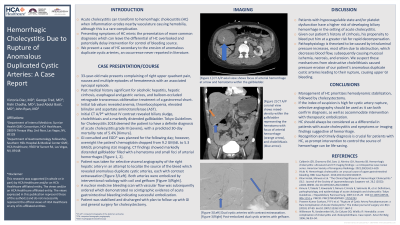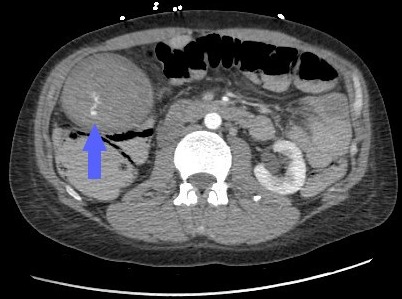Sunday Poster Session
Category: Biliary/Pancreas
P0154 - Hemorrhagic Cholecystitis Due to Rupture of Anomalous Duplicated Cystic Arteries: A Case Report
Sunday, October 22, 2023
3:30 PM - 7:00 PM PT
Location: Exhibit Hall

Has Audio
- VD
Victoria Diaz, MD
Sunrise Health GME Consortium
Las Vegas, NV
Presenting Author(s)
Victoria Diaz, MD1, George Trad, MD1, Rishi Chadha, MD1, Syed Abdul Basit, MD2, John Ryan, MD2
1Sunrise Health GME Consortium, Las Vegas, NV; 2Southern Hills Medical Center, Las Vegas, NV
Introduction: Hemorrhagic cholecystitis (HC) is a rare complication of acute cholecystitis (AC). Symptoms are
nonspecific and may mimic AC or gastrointestinal bleed. Clinical presentation of HC could be
mistaken for much more common diagnoses and overlooked as a differential, delaying
intervention. Herein, we present a case of HC secondary to acute cholecystitis that was complicated
by erosion of anomalous duplicate cystic arteries, an occurrence never before reported in the
literature.
Case Description/Methods: A 33-year-old male with a past medical history of alcoholic cirrhosis presented with complaints of
right upper quadrant pain, nausea, and hematemesis. Downtrending hemoglobin and platelets, with
elevated bilirubin and aspartate aminotransferase (AST) were seen on labs. Initial imaging
demonstrated cholelithiasis and a distended gallbladder containing a hematoma and small foci of
arterial hemorrhages. Selective angiography of the right hepatic artery revealed underlying
anomalous duplicate cystic arteries, each with contrast extravasation. Successful embolization of
bilateral cystic arteries was accomplished and the patient stabilized.
Discussion: HC refers to AC complicated by hemobilia. Patients with hypocoagulable state and/or platelet
dysfunction have a higher risk of developing biliary hemorrhage in the setting of AC. Given our
patient’s history of cirrhosis, his propensity to bleed and risk for rapid decompensation was
increased. Pathophysiology is theorized to be a result of intraluminal pressure increases, most often
due to obstruction, which decreases blood flow, subsequently causing mucosal ischemia, necrosis,
and erosion. We suspect these mechanisms from the obstructive cholelithiasis led to hemorrhagic cholecystitis which was then complicated by the erosion of our patient's anomalous duplicate cystic arteries, leading to their rupture and causing upper gastrointestinal bleeding. If the index of suspicion is high for cystic artery rupture, selective angiography should be used as it can both confirm diagnosis, as well as facilitate intervention with therapeutic embolization. Management of HC requires hemodynamic stabilization, followed by cholecystectomy. HC should always be considered as a differential in AC patients with symptoms or imaging suggestive of hemorrhage. Recognition and timely diagnosis is crucial for affected patients, as prompt
intervention to control the source of hemorrhage, followed by cholecystectomy, can be life-saving.

Disclosures:
Victoria Diaz, MD1, George Trad, MD1, Rishi Chadha, MD1, Syed Abdul Basit, MD2, John Ryan, MD2. P0154 - Hemorrhagic Cholecystitis Due to Rupture of Anomalous Duplicated Cystic Arteries: A Case Report, ACG 2023 Annual Scientific Meeting Abstracts. Vancouver, BC, Canada: American College of Gastroenterology.
1Sunrise Health GME Consortium, Las Vegas, NV; 2Southern Hills Medical Center, Las Vegas, NV
Introduction: Hemorrhagic cholecystitis (HC) is a rare complication of acute cholecystitis (AC). Symptoms are
nonspecific and may mimic AC or gastrointestinal bleed. Clinical presentation of HC could be
mistaken for much more common diagnoses and overlooked as a differential, delaying
intervention. Herein, we present a case of HC secondary to acute cholecystitis that was complicated
by erosion of anomalous duplicate cystic arteries, an occurrence never before reported in the
literature.
Case Description/Methods: A 33-year-old male with a past medical history of alcoholic cirrhosis presented with complaints of
right upper quadrant pain, nausea, and hematemesis. Downtrending hemoglobin and platelets, with
elevated bilirubin and aspartate aminotransferase (AST) were seen on labs. Initial imaging
demonstrated cholelithiasis and a distended gallbladder containing a hematoma and small foci of
arterial hemorrhages. Selective angiography of the right hepatic artery revealed underlying
anomalous duplicate cystic arteries, each with contrast extravasation. Successful embolization of
bilateral cystic arteries was accomplished and the patient stabilized.
Discussion: HC refers to AC complicated by hemobilia. Patients with hypocoagulable state and/or platelet
dysfunction have a higher risk of developing biliary hemorrhage in the setting of AC. Given our
patient’s history of cirrhosis, his propensity to bleed and risk for rapid decompensation was
increased. Pathophysiology is theorized to be a result of intraluminal pressure increases, most often
due to obstruction, which decreases blood flow, subsequently causing mucosal ischemia, necrosis,
and erosion. We suspect these mechanisms from the obstructive cholelithiasis led to hemorrhagic cholecystitis which was then complicated by the erosion of our patient's anomalous duplicate cystic arteries, leading to their rupture and causing upper gastrointestinal bleeding. If the index of suspicion is high for cystic artery rupture, selective angiography should be used as it can both confirm diagnosis, as well as facilitate intervention with therapeutic embolization. Management of HC requires hemodynamic stabilization, followed by cholecystectomy. HC should always be considered as a differential in AC patients with symptoms or imaging suggestive of hemorrhage. Recognition and timely diagnosis is crucial for affected patients, as prompt
intervention to control the source of hemorrhage, followed by cholecystectomy, can be life-saving.

Figure: Computed tomography angiography (CTA) of the abdomen demonstrated a markedly distended gallbladder filled with a hematoma and small foci of arterial hemorrhages
Disclosures:
Victoria Diaz indicated no relevant financial relationships.
George Trad indicated no relevant financial relationships.
Rishi Chadha indicated no relevant financial relationships.
Syed Abdul Basit indicated no relevant financial relationships.
John Ryan indicated no relevant financial relationships.
Victoria Diaz, MD1, George Trad, MD1, Rishi Chadha, MD1, Syed Abdul Basit, MD2, John Ryan, MD2. P0154 - Hemorrhagic Cholecystitis Due to Rupture of Anomalous Duplicated Cystic Arteries: A Case Report, ACG 2023 Annual Scientific Meeting Abstracts. Vancouver, BC, Canada: American College of Gastroenterology.
